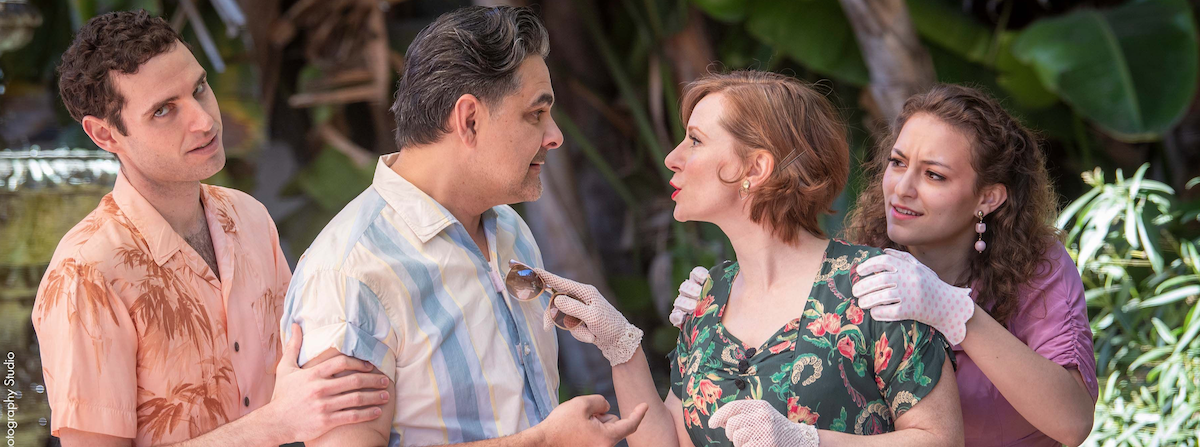Photos by Luis Escobar, Reflections Photography Studio
When it comes to Shakespeare and his much-performed comedy Much Ado About Nothing, “I think he means to delight us—pure and simple,” says Andrew Philpot in his director’s notes for PCPA’s current version of the much-loved play, now at the Marian Theatre in Santa Maria until March 2.
Certainly, he and his actors take much delight in savoring the Bard’s well-turned phrases and in stretching their witty banter out with some silly slapstick that might well have been inspired by one of The Great American Melodrama’s productions.
The machinations—however malevolent or mischievous—keeping Claudio (Michael Gould) and Hero (Lily Cameron) apart, and those getting Beatrice (Emily Trask) and Benedick (George Walker) together, all still lead to the happy ending that audiences expect from such melodrama.
Gould, Cameron, Trask, and Walker—with Philpot’s deft direction—are all well up to the task of helping us make sense of Shakespeare’s Elizabethan English, so we are never in doubt about what’s going on or what a character is thinking.

Trask and Walker are particularly adept at keeping us in the loop, especially in monologues where we share in the “will-they-or-won’t they” nature of their relationship. The appealing, commanding Cordell Cole as Don Pedro also makes himself abundantly clear, as do Erik Stein (at his funniest and most outrageous) and the versatile Peter Hadres, who play two bumbling members of the local constabulary.
Philpot has chosen to set the play somewhere in the mid-20th century, with Tracee Bear’s precise costuming ranging from lovely evening wear to campy shorts-with-heels for the women, and beautiful linen suits to ambiguous military uniforms for the men.
The vigorous and romantic scenic design by Jason Bolen, however, could be any small-town square in Italy from Shakespeare’s day to this—with the exception of some electric lights and a neon sign reading “Cinema”—the latter bringing up a few questions.
As the show begins, cast members light up the sign and unveil a set of movie theatre seats downstage, and thus we are transported with lights and sound to what we must conclude is the beginning of a film being watched by the actress we later encounter playing Hero. We are then ushered into Shakespeare’s play (with a delightful ending choreographed by Jay Brenneman) after which we once again return to the movie theatre, where the actress is quickly joined by the actor playing Claudio.
Why do we need this framework? Is it to somehow set the stage for the shift in time period from the traditional Elizabethan era? Does it help us focus on how different 20th century mores are from those of the 16th century? (Philpot himself notes the ongoing relevance of the question “Why do men still make so many decisions for women?”)
In the end, this Much Ado About Nothing is a delight—pure and simple, with appealing performances and beautiful technical support.
Editor’s Note: If you have questions, you might want to attend a “Prologue with Director Andrew Philpot” scheduled Saturday, February 22 at 1 p.m. which is included with the show that begins at 1:30 p.m. A “Talkback” also is scheduled following the Sunday, February 23 performance.
